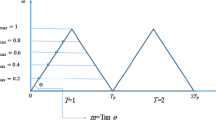Abstract
Direct numerical simulations of Taylor-Couette flow from R e= 8000 to 25000 have been conducted to investigate changes of turbulence statistics in the transition of the Reynolds number dependency of the mean torque near R e= 10000. The velocity fluctuations are decomposed into the contributions of the Taylor vortex and remaining turbulent fluctuations. Significant Reynolds number dependencies of these components are observed in the radial profiles of the Reynolds stress and the transmission of the mean torque. The contributions of Taylor vortex and turbulent components in the net amount of mean torque are evaluated. The Taylor vortex component is overtaken by the turbulent counterpart around R e= 15000 when they are defined as the azimuthally averaged component and the remnants. The results show that the torque transition can be explained by the competition between the contributions of azimuthally averaged Taylor vortex and the remaining turbulent components.










Similar content being viewed by others
References
Wendt, F.: Turbulente strömungen zwischen zwei rotierenden konaxialen zylindern. Arch. Appl. Mech. 4(6), 577–595 (1933)
Doering, C.R., Constantin, P.: Energy dissipation in shear driven turbulence. Phys. Rev. Lett. 69(11), 1648 (1992)
Lathrop, D.P., Fineberg, J., Swinney, H.L.: Transition to shear–driven turbulence in Couette–Taylor flow. Phys. Rev. A 46(10), 6390 (1992)
Lathrop, D.P., Fineberg, J., Swinney, H.L.: Turbulent flow between concentric rotating cylinders at large Reynolds number. Phys. Rev. Lett. 68(10), 1515 (1992)
Lewis, G.S., Swinney, H.L.: Velocity structure functions, scaling, and transitions in high–Reynolds–number Couette-Taylor flow. Phys. Rev. E 59(5), 5457 (1999)
Eckhardt, B., Grossmann, S., Lohse, D.: Scaling of global momentum transport in Taylor–Couette and pipe flow. Eur. Phys. J. B-Condens. Matter Complex Syst. 18 (3), 541–544 (2000)
Eckhardt, B., Grossmann, S., Lohse, D.: Torque scaling in turbulent Taylor–Couette flow between independently rotating cylinders. J. Fluid Mech. 581, 221–250 (2007)
van Gils, D.P., Huisman, S.G., Bruggert, G.W., Sun, C., Lohse, D.: Torque scaling in turbulent Taylor–Couette flow with co–and counterrotating cylinders. Phys. Rev. Lett. 106(2), 024–502 (2011)
Grossmann, S., Lohse, D., Sun, C.: High Reynolds number Taylor–Couette turbulence. Ann. Rev. Fluid Mech. 48, 53–80 (2016)
Dong, S.: Direct numerical simulation of turbulent Taylor–Couette flow. J. Fluid Mech. 587, 373–393 (2007)
He, W., Tanahashi, M., Miyauchi, T.: Direct numerical simulation of turbulent Taylor-Couette flow with high Reynolds number. In: Advances in Turbulence XI, pp 215–217. Springer (2007)
Pirro, D., Quadrio, M.: Direct numerical simulation of turbulent Taylor–Couette flow. Eur. J. Mech.-B/Fluids 27(5), 552–566 (2008)
Fukushima, N., Fushimi, T., Shimura, M., Tanahashi, M., Miyauchi, T.: Dynamics of large–and small–scale vortical structures in turbulent Taylor–Couette flow. Proceedings Turbulent Shear Flow Phenomena 7 (2011)
Ostilla-Mónico, R., van der Poel, E.P., Verzicco, R., Grossmann, S., Lohse, D.: Boundary layer dynamics at the transition between the classical and the ultimate regime of Taylor–Couette flow. Phys. Fluids 26(1), 015–114 (2014)
Marcus, P.S.: Simulation of Taylor–Couette flow. part 1. numerical methods and comparison with experiment. J. Fluid Mech. 146, 45–64 (1984)
Taylor, G.I.: Stability of a viscous liquid contained between two rotating cylinders. Philos. Trans. Royal Soc. London. Ser. A Contain. Papers Math. Phys. Charact. 223, 289–343 (1923)
Burkhalter, J., Koschmieder, E.: Steady supercritical taylor vortices after sudden starts. Phys. Fluids 17(11), 1929–1935 (1974)
Tanahashi, M., Kang, S.J., Miyamoto, T., Shiokawa, S., Miyauchi, T.: Scaling law of fine scale eddies in turbulent channel flows up to R e τ =800. Int. J. Heat Fluid Flow 25(3), 331–340 (2004)
Hoyas, S., Jiménez, J.: Reynolds number effects on the Reynolds-stress budgets in turbulent channels. Phys. Fluids 20(10), 101–511 (2008)
Bilson, M., Bremhorst, K.: Direct numerical simulation of turbulent Taylor–Couette flow. J. Fluid Mech. 2(R1), 2–2 (2007)
Huisman, S.G., Scharnowski, S., Cierpka, C., Kähler, C. J., Lohse, D., Sun, C.: Logarithmic boundary layers in strong Taylor–Couette turbulence. Phys. Rev. Lett 110(26), 264–501 (2013)
Acknowledgments
This work is partially supported by Grant-in-Aid for Scientific Research (S) (No.23226005) of Japan Society for the Promotion of Science.
Author information
Authors and Affiliations
Corresponding author
Appendix: A Relation between the Torque Transmission and the Net Mean Torque
Appendix: A Relation between the Torque Transmission and the Net Mean Torque
A relation between the torque transmission in Eq. 3 and the net mean torque in Eq. 4 can be derived in the following steps. The local force in the azimuthal direction driving infinitesimal volume of fluid is written as Eqs. 9 and 10 when they are averaged in azimuthal and axial directions and in time.
〈〈u r u θ 〉 θ 〉 z in the right hand side of Eq. 9 is equal to R r θ \(=\langle \langle {u_{r}^{\prime }u_{\theta }^{\prime }\rangle _{\theta }\rangle }z\) since 〈〈u r 〉 θ 〉z=0. Equations 9 and 10 give the expression of the Reynolds stress and the viscous terms for the driving force as follows,
Then Eq. 13 can be derived by substituting Eqs. 11 and 12 into Eq. 3
Here the second term of the right hand side in Eq. 12 can be transformed to \(r^{2}/{r^{2}_{i}}G(r)\) using Eq. 3 at r = r i . By considering r = r o in Eq. 13, a whole domain can be taken in account and Eq. 4 is derived.
Rights and permissions
About this article
Cite this article
Osawa, K., Naka, Y., Fukushima, N. et al. Effect of Flow Structures on Turbulence Statistics of Taylor-Couette Flow in the Torque Transition State. Flow Turbulence Combust 97, 973–986 (2016). https://doi.org/10.1007/s10494-016-9770-1
Received:
Accepted:
Published:
Issue Date:
DOI: https://doi.org/10.1007/s10494-016-9770-1




